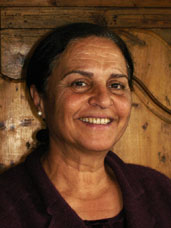Menu

Sumaya Farhat-Naser: The Wall
The Palestinian writer, teacher and peace activist describes the construction in Palestine, September 2003:
"...The WALL between our two peoples being built by force supports the ideology of land-taking and the exclusion of Palestinians. UN resolutions, human rights and international conventions as well as signed treaties are ignored and bypassed. Neither ethics nor justice, but power alone determines policy today.
The terms ŌĆ×protective, or security fenceŌĆ£, ŌĆ×partition wallŌĆ£, ŌĆ×barrierŌĆ£ or ŌĆ×Apartheid WallŌĆ£ confuse, disguise the reality and clearly show the contradictions between the national interests of the two peoples. If walls guarantee security, why arenŌĆśt they built to guarantee security in other countries? The answer is simple: an occupation rules here, one that wants land, and continually seeks to ŌĆÜstarve outŌĆś the Palestinians.
A map published in the August 25th, 1978 newspaper ŌĆ£Al HamishmarŌĆØ showed even then SharonŌĆÖs ideal in terms of the occupied territories. The areas that were to be left to the Palestinians then were very similar to the areas remaining after construction of the wall. Is a dream (or nightmare) now being realized, 25 years later?
A sentence from an Israeli politician rings in my ears: ŌĆ×In war people do things that cannot be done in normal times.ŌĆ£
Chaos and a spiraling of violence and counter-violence creates an ideal situation for things to happen in other areas ŌĆō almost unnoticed by the international public:
The 1967 border of Israel (the so-called Green Line) is 360 kilometers long. The planned wall is more than 1000 km long, because it weaves its way deep into the occupied territories. The first section of 145 km has been completed. A short description of this first phase follows. It is based on an April 2003 report entitled ŌĆ×Behind The BarrierŌĆ£ from BŌĆÖTselem, an Israeli human rights organization:
The separation wall, also called the barrier, is made partly from concrete and partly from barbed-wire fencing.
Elements of the wall include: electric fences with warning signals, as well as watch towers with sharp-shooters. On the eastern side of the barrier there is a so-called ŌĆ×service roadŌĆ£ encircled by a barbed-wire fence. To the east of this are trenches, a few meters deep and wide. On the western side of the barrier are a control strip and a lane for tanks. Behind these is a second barbed-wire fence.
The wall reaches six to seven km deep into the West Bank, to secure the hinterland for settlements. It creates enclaves in the border area between the two parallel demarcations. The wall takes around 161,700 Dunum from the Palestinians, which amounts to 2,9% of the West Bank. It affects 210,000 inhabitants of 67 villages and cities.
Many municipalities and people will also be arbitrarily separated from their lands. Their houses lie to the west, their properties are east of the wall. 72,200 inhabitants of 36 villages are affected.
- 32 wells = 18% of the western water reserves, are hemmed in by the wall and thus lost to the Palestinians.
- A connecting road, which will give the Israelis free passage from north to south right through the middle of the West Bank, will monopolize 17% of the occupied territory, because a zone as big as three soccer fields on both sides of the street will be taken as a security zone.
Five main gates and 26 ŌĆ×agricultural gatesŌĆ£ have been built; at each one permits for passage will be controlled. It is very difficult to get such permits. The application, or rather the approval, can take days, sometimes weeks.
This limitation on the mobility of people harms the economy, education and social life. The losses of land and property are already immense and threaten the existence of the Palestinians to an even greater extent than before. What will it be like when the wall is finished? An observer might well presume that this is all related to making life so difficult for people that they cannot stand it any more and will decide to leave their country. Is that the way to create security?
Current policy enthusiastically supports construction of the wall, ignoring the damage and misery which will befall Israeli society and the people of Israel and Palestine.
The Hudna - Cease-fire
It was finally possible to achieve a hudna, or cease-fire, on the Palestinian side. An atmosphere of hope and relief could be felt, combined with an improvement in the daily situation. But the hudna was not appreciated by the Israeli military because it would mean that military actions would have to stop. The tactic of Ben Gurion fit exactly: ŌĆØProvoke, to get a reaction: we say yes if they say no, and we say no if they say yes.ŌĆØ
The Israeli government let it be known that the hudna was a Palestinian affair, and that Israel would continue unabated with its policy of elimination of political activists. The military described the hudna as follows, according to Israeli writer Uri Avnery: ŌĆØEvery day of hudna is a disaster! The reduction of violence to a level of zero is a great misfortune: under the disguise of the hudna, terrorist organisations can recover and regroup. Every attack that is prevented today will hit us harder tomorrow.ŌĆØ
Within the first six weeks of the cease-fire, Israeli soldiers killed 21 Palestinians and injured more than 160 people during the so-called ŌĆ£targeted killingŌĆØ of activists. They fired rockets and bombs on open streets, so that many civillians, including children, were killed or injured. Destruction of houses, taking of land and construction of the wall continued. Thus the cease-fire was condemned to failure.
A cycle of violence and and counter-violence began. On August 8th Israeli soldiers killed two Hamas fighters in Nablus. The retribution took place on August 12th, six weeks after the start of the cease-fire on the Palestinian side. Hamas fighters killed an Israeli in Rosh-HaŌĆÖayn and a settler in the Ariel settlement. That was the beginning of a new outbreak and escalation of violence. Every day people were killed, others were injured, imprisoned and tortured.
The suffering is dreadful and blocks the path to reconciliation. As long as occupation, repression and injustice rule, there will be resistance. Thousands are ready to defend themselves ŌĆō and by all means possible. How many will have to be killed, and how will it be possible that no future generations of fighters will follow? The answer is: stop the occupation, and find a just solution reflecting international legitimacy, which would bring true peace to both sides. Both societies are suffering terribly and are increasingly sickened by the loss of humanity and morality. We need an international intervention that will help bring both sides to reason. Attacks on civilians, and every murder, are crimes that should never be accepted. This cycle has to end immediately. Every injury, every death, every injustice deepens the hostility and makes the healing and recovery more difficult on both sides. We need to make an accounting for ourselves, we have to admit our failures and take responsibility. We have to keep our humanity and find our reason once again.
Your Sumaya Farhat-Naser
Birzeit, Palestine"


